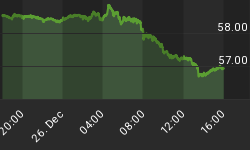One reason the market has been struggling to work meaningfully higher for nearly two years is that we haven't seen any panic-stricken, oversold extremes. Sure, everyone can name a handful of things they're worried about - today it would likely be oil, interest rates, bird flu, a new Fed Chairman and turmoil at the White House - but we just haven't seen evidence of a washout in sentiment for quite some time.
Recently, however, signs of increasing investor fear have emerged: this month alone the put/call ratio has registered two separate strings of five and three consecutive days of readings above 1. Such readings are unusual since more call options are typically bought each day, while strings of such statistics are rare and have historically signaled that an important bottom is near. Further, Mark Hulbert's sentiment survey of investment professionals recently logged a bearish reading unlike any he has seen.
As strange as this may sound, a little more selling, perhaps even a big down day or two, would be good for the market as it would likely bring the type of capitulation that would finally allow for another sustained move higher.
Making things particularly difficult right now, however, is the fact that a select few gauges are suggesting that enough selling has already occurred.
For example, one short-term technical indicator I value is the Hi-Low Index, which measures new 52-week highs as a percentage of total 52-week highs and lows and records that number as a 10-day moving average. This tool has served me well as an early warning indicator that a change in trend may be coming. Typically, readings below 30 (meaning only 30% of total highs and lows are new highs) tend to reveal oversold conditions, but readings near single digits suggest an extremely washed out state. The Hi-Low is included below in Point & Figure form, with O's representing declines and X's depicting periods when this gauge was rising:

As can be seen above, this gauge has already bottomed and reversed higher in recent days. More importantly, however, the last time this indicator saw such washed-out levels was in February of 2003, when the S&P 500 was saying goodbye to its low near 800 for good. The only two other periods with readings near this level were August of 2004 and April of 2005, both of which also witnessed impending turns higher in the market.
Normally, I'd prefer to see longer-term technical indicators, many of which have declined substantially in recent weeks but are not grossly oversold, become washed out along with this and other short-term measures. Indeed, since more technical gauges aren't washed out, risk remains for more downside stock market action from here. However, the fear that unquestionably rests in most investors' minds today along with the hopeful signals from indicators like the ones mentioned above cause me to believe that we're closer to the end of the latest pullback than the beginning.
Unfortunately, rarely does a fire alarm ring telling all investors to buy, that this is the bottom. While a washed-out, frightening sell-off would be ideal, the HiLo indicator and a few others suggest that we might not get such a clear signal. Indeed, aggressive investors can already look to start nibbling on selected stocks - slowly, cautiously - and longer-term investors should at least be starting to determine which sectors they might like to do some buying in should a final washout soon take place.
















